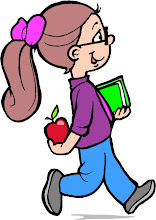We are continuing with Bedtime Math. K. really likes doing it.
We spent the first week on lesson five of Professor Pig and playing the games from previous lessons. Lesson five is about the "9 Trick". When adding a number to 9, take one from the other number and add it to the 9 to make 10, then add.
In the second week we worked on more of the fraction workbook: Comparing Fractions, Adding Fractions, and Subtracting Fractions. We also played some games from
Fabulous Fractions.
- Fraction Math -- played like a memory game, but the matches are equivalent fractions, so 2/4 and 1/2 would be a match. Each card has the fraction with an illustration of the fraction, which makes it easy to tell if they are equivalent.
- Combination Pizza -- we didn't actually play this the way it is in the book (we probably will later), but I had K. make the pizzas and I cut them up. I used it to help her understand that 12/8 is the same a 1 4/8 or 1 1/2.
The third week we practiced with multiplication and skip counting. Some was review from last year and some was new. Some were ideas from
Marvelous Multiplication and some I thought up.
- 1's -- you need 10 napkins and 10 jelly beans, also write out the times tables (1 x 1, 2 x 1, 3 x 1,etc.). Put out one napkin with one jelly bean. This illustrates 1 x 1 (1 set of 1 jelly bean). Have your child write the answer on their times table chart. Continue with two napkins with 1 jelly bean on each (2 x 1), etc.
- 2's -- use pairs of socks; I also printed out a sheet with 10 pairs of socks (easy to use for skip counting)
- 3's -- I printed out a sheet with 10 tricycles on it
- 4's -- we used the Counting Corners game from last year; I also printed out a sheet with 10 buttons that each have four holes.
- 5's -- use nickles; I printed out a sheet with pictures of 10 nickles
- 6's -- I printed a sheet with 10 insects (make sure the six legs of each insect shows)
- 7's -- I had 70 toothpicks. K. put them in groups of 7 and I put rubber bands around them; I also printed out a sheet with 10 sets of 7 toothpicks
- 8's -- I pulled 10 Lego blocks from her room that had 8 bumps; I also printed out a sheet with pictures of the Lego blocks
- 9's -- I taught her the hand/finger method
- 10's -- I printed out a sheet with 10 sets of hands (last year we made a big sheet with 10 sets of her hands)
- 0's -- played with 1, 2, or more sets of 0 and 0 sets of 3, 4, 5 or more; either way, there is still zero
- Cover-Up! -- The instructions for this game are in Second Grade, Math, Set Four. We decided that any dominoes with a zero are also wild.
- Fingers! -- Two players each hind one hand; one player calls, "Ready, set, fingers!" When "fingers" is called, both players bring out their hidden hand, showing either 0, 1, 2, 3, 4, or 5 fingers. Both players multiply the number of fingers shown on each players hands. (Example: player one shows 3 fingers, player two shows 5 fingers; 3 x 5 = 15) The first player to call out the correct answer wins an F (the first letter in FINGERS). The first player to spell the word FINGERS is the winner.
In the fourth week we worked on angles, playing these games from
Groovy Geometry.
- Measure Up -- Use a protractor to measure six angles around the room. What size angle do you find the most? Cut two strips of card stock about 1 inch by 8 inches. Draw a line down the middle of each. Attach them together at one end with a brad. Use it to make different size angles to measure.
- Draw It -- Cut two sheets of paper into eight pieces. On each piece write the degree of an angle, starting at 10 degrees and ending at 170 degrees. Fold the papers and put them in a bowl. Player 1 picks out a paper and tries to draw an angle that is that degree (or you can use the angle maker you made in Measure Up). In the book there is more to the game, including how to score points.
- Name Game -- Write one angle degree on each of 16 index cards (from 10 degrees to 160 degrees). Deal eight cards to each player. Both players turn over their top card at the same time and call whether the angle is acute, right, or obtuse. An obtuse angle beats right and acute; right beats acute. Winner gets to keep both cards. If both angles are obtuse or acute, player with the larger angle wins. When all cards have been played, the player with the most cards wins.
- Shape Lotto -- see Kindergarten, Math, Week 19 for instructions
We worked on map skills in week five. I have the book
Map Skills Made Fun: Neighborhoods and Communities by Catherine M. Tamblyn. K. also did some addition and subtraction problems each day.
